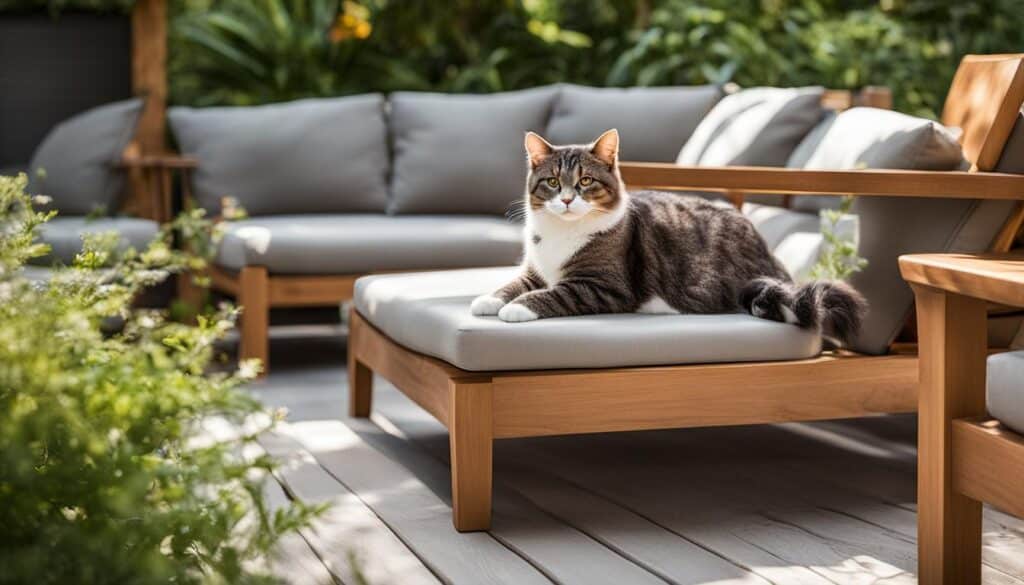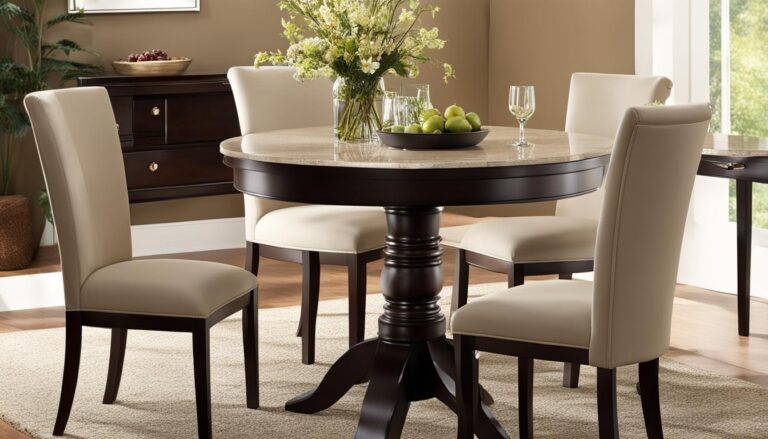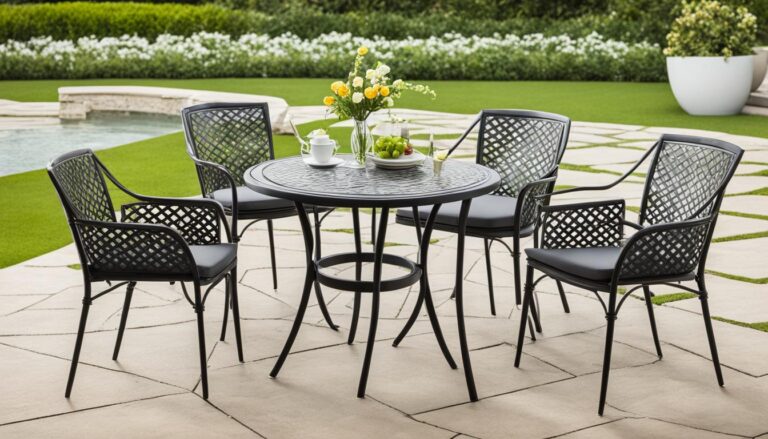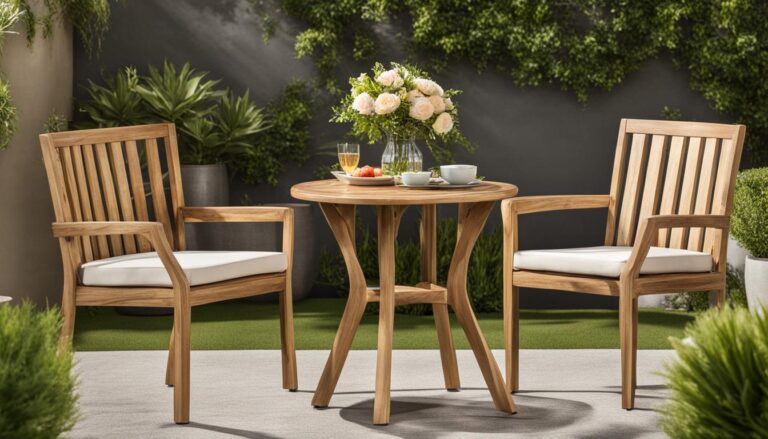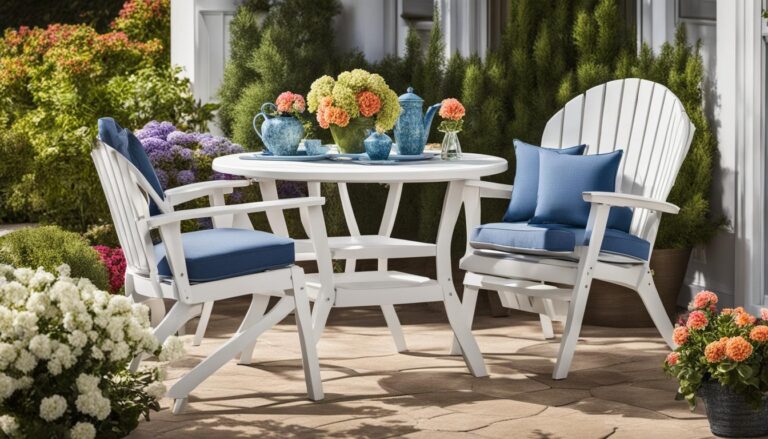Cats can be attracted to outdoor furniture for various reasons, such as comfort or the need to scratch. However, their presence can lead to scratches, hair, and other damages. Here are some effective strategies to keep cats off your outdoor furniture.
Key Takeaways:
- Use natural repellents like vinegar, water, and liquid hand soap to deter cats from outdoor furniture.
- Consider using commercial cat repellents specifically designed to keep cats away from outdoor furniture.
- Physical barriers such as aluminum foil or double-sided tape can create deterrents for cats.
- Train your cat to stay off outdoor furniture using verbal commands and positive reinforcement.
- Create a cat-friendly area with a cat tree or feline lounging area to redirect your cat’s attention.
Natural Repellents to Keep Cats Away from Outdoor Furniture
If you’re looking for a natural and effective way to keep cats off your outdoor furniture, natural repellents can be a great solution. Cats are sensitive to certain smells, so using homemade repellents can deter them from approaching your furniture. One simple recipe for a homemade cat deterrent is a mixture of vinegar, water, and liquid hand soap. Cats dislike the smell of vinegar, and the soap helps it stick to the furniture. To make this repellent, combine equal parts vinegar and water, and add a few drops of liquid hand soap. Mix it well and spray the solution onto your outdoor furniture.
In addition to vinegar, there are other natural repellents that can help keep cats away. Mothballs and potpourri made with citrus peels can be effective in deterring cats. Cats dislike the strong smell of mothballs, so placing them near your furniture can discourage them from approaching. Citrus peels, such as orange or lemon peels, can also be used as a natural cat repellent. Simply scatter the peels around your furniture to create a scent that cats find unpleasant.
It’s important to note that these natural repellents are safe for both cats and the environment. They provide a humane way to deter cats from your outdoor furniture without causing harm. However, it may take some trial and error to find the right repellent that works for your specific situation. Keep in mind that cats’ preferences can vary, so what works for one cat may not work for another.
Table: Comparison of Natural Repellents for Outdoor Furniture
| Repellent | Ingredients | Effectiveness |
|---|---|---|
| Vinegar Spray | Vinegar, water, liquid hand soap | Effective for some cats, but may require reapplication |
| Mothballs | Naphthalene or paradichlorobenzene | Effective for most cats, but should be used with caution due to toxicity |
| Citrus Peels | Orange or lemon peels | Effective for some cats, but may require frequent replacement of peels |
Using natural repellents can be a cost-effective and eco-friendly way to keep cats away from your outdoor furniture. However, it’s important to remember that no method is foolproof, and some cats may be more persistent than others. If natural repellents alone are not enough, you may need to consider combining them with other strategies, such as commercial repellents or physical barriers, to ensure the desired results.
Commercial Cat Repellents for Outdoor Furniture
In addition to natural repellents, there are also commercial cat repellents available that are specifically designed to keep cats away from your outdoor furniture. These repellents come in liquid form and can be easily applied to the furniture using a spray bottle. The liquid repellents work by emitting smells that are unpleasant to cats, deterring them from approaching and scratching the furniture.
One popular option is the “Cat Repellent Spray” by XYZ Brand, which is made with natural ingredients and has a fresh citrus scent. Simply spray it onto your outdoor furniture, and the cats will be deterred by the smell. Another effective product is the “Outdoor Cat Repellent Granules” by ABC Brand. These granules can be sprinkled around the furniture to create a barrier that cats dislike.

When using commercial cat repellents, it is important to read and follow the instructions carefully. Some repellents may need to be reapplied after rain or heavy humidity to maintain their effectiveness. It’s also a good idea to test the repellent on a small, inconspicuous area of your furniture first to ensure it does not cause any damage or discoloration.
Comparison of Commercial Cat Repellents for Outdoor Furniture
| Product | Features | Duration of Protection | Price |
|---|---|---|---|
| Natural’s Mace Cat Repellent Spray | Natural ingredients, citrus scent | 24 hours per application | $10.99 |
| Bonide Outdoor Cat Repellent Granules | Creates a barrier, long-lasting | Up to 2 weeks per application | $14.99 |
| Natural’s Mace Cat Repellent Concentrate | Mix with water, easy to apply | Varies, depending on dilution | $19.99 |
Note: Prices may vary. Check the product labels for the most up-to-date information.
Physical Barriers and Deterrents for Outdoor Furniture
When it comes to keeping cats off your outdoor furniture, physical barriers and deterrents can be highly effective. These methods create an unpleasant experience for cats, deterring them from approaching and damaging your furniture. Here are a few options you can consider:
Aluminum Foil
Aluminum foil can be a simple yet effective deterrent for cats. Cats dislike the texture and noise that aluminum foil creates when they walk on it. By placing sheets of aluminum foil on your outdoor furniture, you can discourage cats from jumping or scratching on the surfaces. This method is safe and does not cause any harm to the cats.
Double-Sided Tape
Another practical option is using double-sided tape. Cats dislike the sticky sensation of tape on their paws, making them avoid areas where tape is applied. Attach strips of double-sided tape to the edges or surfaces of your outdoor furniture to deter cats from approaching or scratching. Ensure that the tape is securely attached to prevent it from easily being removed by the cats.
Motion-Activated Sprinklers or Lights
If you’re looking for a more high-tech solution, consider installing motion-activated sprinklers or lights near your outdoor furniture. These devices use sensors to detect the presence of cats and trigger a burst of water or turn on bright lights. The sudden spray of water or unexpected illumination startles cats and teaches them to associate the furniture with an unpleasant experience. This method is particularly useful for larger outdoor areas or gardens.
| Method | Effectiveness | Ease of Use | Cost |
|---|---|---|---|
| Aluminum Foil | High | Easy | Low |
| Double-Sided Tape | Medium | Easy | Low |
| Motion-Activated Sprinklers or Lights | High | Moderate | Medium to High |
These physical barriers and deterrents provide effective solutions to keep cats away from your outdoor furniture. Choose the method that best suits your needs, budget, and the specific areas you want to protect. By implementing these measures, you can create a cat-free zone and preserve the integrity of your outdoor furniture.
Training and Command to Keep Cats Off Outdoor Furniture
Training your cat to stay off outdoor furniture requires consistency, patience, and positive reinforcement. By using verbal commands and redirecting their behavior, you can effectively deter them from climbing, scratching, or lounging on your outdoor furniture.
Start by using simple verbal commands like “no” or “get down” whenever you catch your cat attempting to climb on the furniture. Be consistent in using these commands and make sure to reinforce positive behavior by rewarding them with treats or praise when they listen to your commands.
A spray bottle filled with water can also be a useful deterrent when your cat refuses to comply with verbal commands. Give a gentle spritz of water near their body, making sure not to directly spray their face. The water spray acts as a negative association and can help discourage them from repeating the unwanted behavior.
Consistency is key when training your cat. Make sure to repeat these training sessions regularly and provide them with alternative, cat-friendly areas where they can satisfy their natural instincts. By combining training with positive reinforcement and creating a cat-friendly environment, you can effectively keep your furry friend off your outdoor furniture.
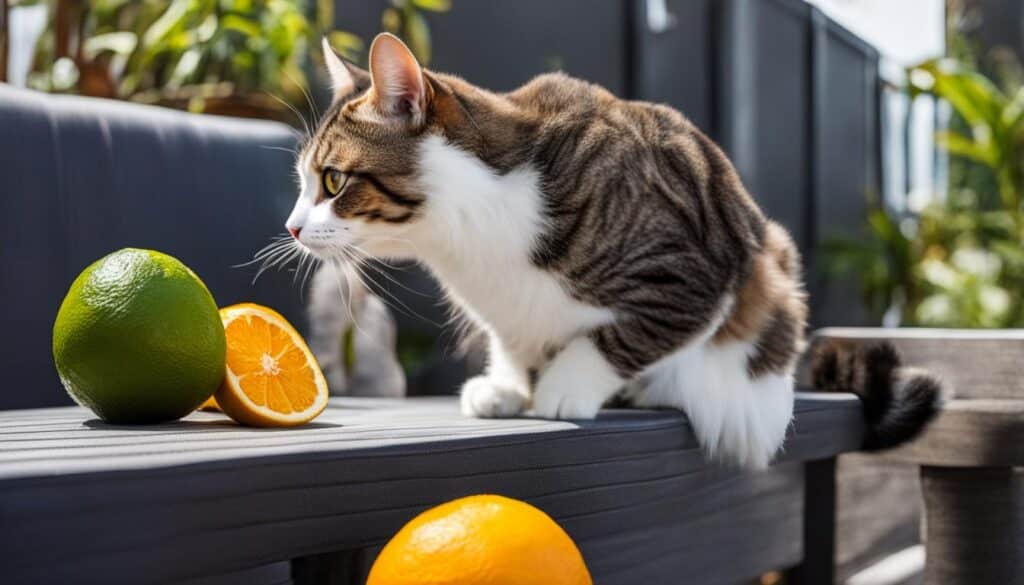
Table: Verbal Commands for Cat Deterrent
| Verbal Command | Meaning/Action |
|---|---|
| No | Command to stop the cat from engaging in unwanted behavior |
| Get down | Command for the cat to come down from furniture or elevated surfaces |
| Off | Command for the cat to leave a specific area or piece of furniture |
| Leave it | Command for the cat to ignore or stop interacting with a specific object |
| Stop | Command for the cat to cease any activity or behavior |
Creating a Cat-Friendly Area to Keep Cats Away from Outdoor Furniture
If you want to keep your cats away from your outdoor furniture, one effective strategy is to create a cat-friendly area that will divert their attention. By providing them with their own space, complete with a cat tree and a feline lounging area, you can give them a comfortable and enticing alternative to your furniture.
A cat tree is a vertical structure that offers cats a place to climb, scratch, and play. It provides them with elevated platforms and perches where they can survey their surroundings and feel safe. By having a cat tree in your outdoor space, you are giving your cats a designated area that is specifically tailored to their needs.
In addition to a cat tree, you can also create a feline lounging area with comfortable hiding spots. This can be achieved by placing cozy blankets or cushions in secluded corners of your outdoor space. Cats love to curl up in small, enclosed spaces, so offering them a hiding spot will make them feel secure and content. You can also include some cat toys or scratching posts in this area to further entice them.
Benefits of a Cat-Friendly Area
Having a cat-friendly area in your outdoor space offers several benefits. Firstly, it redirects your cats’ attention away from your furniture, reducing the chances of them scratching or damaging it. Secondly, it provides them with an enriched environment where they can engage in natural behaviors like climbing and scratching. This can help prevent boredom and promote their overall mental and physical well-being.
Furthermore, by creating a cat-friendly area, you are establishing boundaries and giving your cats a clear understanding of what areas are off-limits. This can aid in training them to stay away from your furniture and focus on their designated space instead.
Overall, a cat-friendly area is a win-win solution for both you and your cats. You can protect your outdoor furniture while providing your furry friends with a space where they can indulge in their natural instincts and feel right at home.
Conclusion
In conclusion, keeping cats off your outdoor furniture requires a combination of effective strategies. By following these tips for cat-proofing your outdoor space, you can ensure a scratch-free and hair-free environment.
Firstly, natural repellents can be a great way to deter cats from your furniture. Homemade repellents using vinegar, water, and liquid hand soap, as well as mothballs and citrus peel potpourri, are safe and effective options.
Secondly, consider using commercially available cat repellents designed specifically for outdoor furniture. These liquid repellents emit unpleasant smells that cats find off-putting, providing long-lasting protection.
Additionally, physical barriers such as aluminum foil or double-sided tape can create deterrents that cats dislike. Motion-activated sprinklers or lights can also startle and discourage cats from approaching your furniture.
Remember, training your cat and providing a designated cat-friendly area are also important. Using verbal commands and positive reinforcement can teach your cat to stay away from the furniture, while offering them their own space with a cat tree or feline lounging area will redirect their attention.
By implementing these strategies, you can keep your outdoor furniture cat-free and enjoy a peaceful and undamaged outdoor space.
FAQ
Why are cats attracted to outdoor furniture?
Cats may be attracted to outdoor furniture for comfort or the need to scratch. They may also be drawn to the scent of previous cats or animals on the furniture.
Do natural repellents work to keep cats off outdoor furniture?
Yes, natural repellents can be effective in deterring cats from outdoor furniture. Vinegar, water, liquid hand soap, mothballs, and citrus peel potpourri can all be used as natural deterrents.
Are there commercially available cat repellents for outdoor furniture?
Yes, there are cat repellents specifically designed for outdoor furniture. These repellents emit smells that cats find unpleasant, deterring them from approaching the furniture.
What are some physical barriers and deterrents that can keep cats off outdoor furniture?
Aluminum foil can create an unpleasant texture and sound, while double-sided tape creates a sticky surface that cats will avoid. Motion-activated sprinklers or lights near the furniture can also startle and deter cats.
Can you train a cat to stay off outdoor furniture?
Yes, with patience and consistency, you can train your cat to stay off outdoor furniture. Using verbal commands and positive reinforcement can help teach your cat to avoid the furniture.
How can I create a cat-friendly area to redirect my cat’s attention from outdoor furniture?
Investing in a cat tree or creating a feline lounging area with comfortable hiding spots can provide a space where your cat can relax and play, redirecting their attention away from the outdoor furniture.

